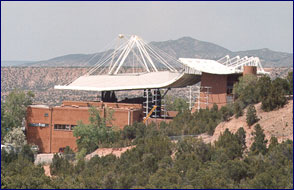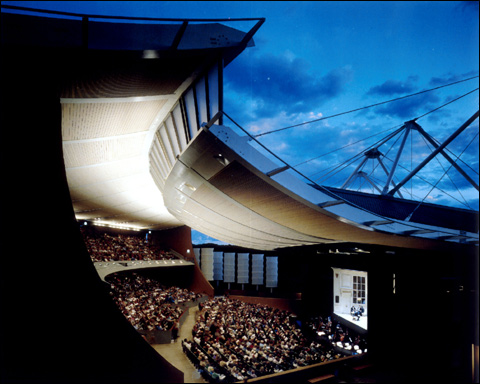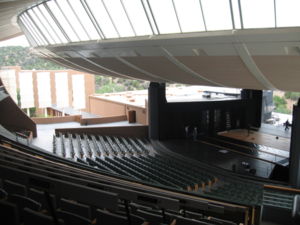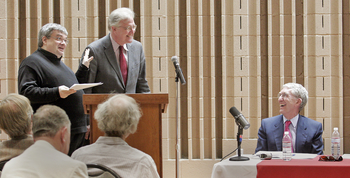The New York Drama Critics’ Circle made its annual awards today. The best-play award went to August: Osage County, the best-musical award to Passing Strange.
To find out how all the judges voted, myself included, go here.
Archives for May 12, 2008
CAAF: Morning coffee
This is the world we made edition:
• Virginia Heffernan reports that the Oxford English Dictionary may soon be out of print as it moves to a web-only format. Luddites cry, “O.E.D. no!” Relatedly, in this week’s Publishers Weekly, Gwenda Bond explores how Wikipedia’s dominance is affecting the publishing model for encyclopedias and other reference works.
• Janet Maslin gives James Frey’s new novel a rave. But the review is written in a bad James Frey imitation. Which made this reader squirm, cringe.
TT: Conjugal leave
Now that Rhythm Man is finished and the Broadway season is over, I’m blowing town for a few days of much-needed rest. Tonight I’ll be dining with Mrs. T somewhere in deepest Connecticut, and anybody who wants to get in touch with me there for any reason not involving a four-figure advance cash payment is out of luck.
Blogging? Fugedaboudit. Except for the usual almanac entries and theater-related postings, I intend to leave you in the hands of OGIC and CAAF all week long. If I break my word, throw stones.
See you next Monday.
P.S. I’ve freshened the Top Five and “Out of the Past” picks, and my colleagues will be adding still more new stuff this week. Take a peek.
TT: Right turn at Albuquerque
 “When I know how long a piece must take, then it excites me,” Igor Stravinsky said to George Balanchine. That’s sort of how I felt when I finally got a look at the stage on which the Santa Fe Opera will give The Letter its first performance next July.
“When I know how long a piece must take, then it excites me,” Igor Stravinsky said to George Balanchine. That’s sort of how I felt when I finally got a look at the stage on which the Santa Fe Opera will give The Letter its first performance next July.
The Crosby Theater is a 2,166-seat open-air house built atop a 7,500-foot-high desert mesa. Here’s how the construction company that built the theater describes it:
The most unique feature of the project is the enormous, and very complex, steel roof structure. The roof rod tensioning system and huge mast assemblies support the roof structure and balcony steel, with the roof connected in tension, and resting on the four existing star columns.
The opera seating is a concrete riser on grade and the balcony seating is a pre-cast riser set on structural steel. The architectural finish is the traditional New Mexican stucco. Special systems that were added include a state-of-the-art theatrical lighting system running throughout 750 lineal feet of catwalk erected above the stage, and computerized dimming capabilities both within the theater and throughout the plaza grounds.
 All this is true enough, I suppose, but only in the limited sense that it would also be true to describe the Empire State Building as rather tall. It’s more to the point, if less exact, to say that the Crosby Theater is the most gorgeous-looking open-air theater I’ve seen in my life–and I’ve seen some beauties. The setting is part of it, of course, but the theater itself is a humdinger, at once spacious and arrestingly intimate. Now that I’m a drama critic, I spend much of my time watching performances in small theaters, and in the process I’ve become impatient with giant-sized auditoriums like the 3,800-seat Metropolitan Opera House, where even the best seats are far removed from the singers on stage. Not so the Crosby Theater. When you stand on the stage, you feel as though you’re in the lap of the audience, and when you sit in the orchestra seats, you feel as though you’re being thrust toward the performers. To build such a theater in so naturally beautiful a place all but ensures a festive atmosphere, and by most accounts the opera buffs who come to Santa Fe do so in the expectation of having a rip-roaringly good time.
All this is true enough, I suppose, but only in the limited sense that it would also be true to describe the Empire State Building as rather tall. It’s more to the point, if less exact, to say that the Crosby Theater is the most gorgeous-looking open-air theater I’ve seen in my life–and I’ve seen some beauties. The setting is part of it, of course, but the theater itself is a humdinger, at once spacious and arrestingly intimate. Now that I’m a drama critic, I spend much of my time watching performances in small theaters, and in the process I’ve become impatient with giant-sized auditoriums like the 3,800-seat Metropolitan Opera House, where even the best seats are far removed from the singers on stage. Not so the Crosby Theater. When you stand on the stage, you feel as though you’re in the lap of the audience, and when you sit in the orchestra seats, you feel as though you’re being thrust toward the performers. To build such a theater in so naturally beautiful a place all but ensures a festive atmosphere, and by most accounts the opera buffs who come to Santa Fe do so in the expectation of having a rip-roaringly good time.
I learned these things when I flew out to Santa Fe two weeks ago to attend the press conference at which the cast and production team of The Letter were announced. I’d never been to Santa Fe before, and didn’t know how complicated it is to get there from New York: you fly into Dallas or Denver, change planes for Albuquerque, then spend an hour driving to Santa Fe. The connections can be dicey, and if you try to cut it close, you’re likely to end up spending the night somewhere else. I flew out of Newark, and my flight left two hours late, the same amount of time I’d allowed myself to change planes in Dallas. Since I was booked onto the last flight to Albuquerque, I assumed that I wasn’t going to get to Santa Fe until the next day, but American Airlines, God bless them, held my plane, and I made it to New Mexico in one piece, more or less on time.
 Paul Moravec, my collaborator on The Letter, picked me up at my hotel the following morning and drove me to the opera house, where the company’s production chief gave us a tour of the grounds. The more I saw, the bigger my eyes grew. Of course I knew perfectly well that Santa Fe Opera is a large-scale operation, but you can’t fully appreciate the implications of that statement until you see the company’s headquarters spread out before you. As I explained to Mrs. T when I got back to New York, Santa Fe Opera is not so much a summer opera company as a major opera company that performs in the summer. Paul told me this after he went there last year–he compared it to Bayreuth–but it wasn’t until I stood on the stage that I understood what he meant.
Paul Moravec, my collaborator on The Letter, picked me up at my hotel the following morning and drove me to the opera house, where the company’s production chief gave us a tour of the grounds. The more I saw, the bigger my eyes grew. Of course I knew perfectly well that Santa Fe Opera is a large-scale operation, but you can’t fully appreciate the implications of that statement until you see the company’s headquarters spread out before you. As I explained to Mrs. T when I got back to New York, Santa Fe Opera is not so much a summer opera company as a major opera company that performs in the summer. Paul told me this after he went there last year–he compared it to Bayreuth–but it wasn’t until I stood on the stage that I understood what he meant.
Paul and I did our best to act like grownups, but as soon as the tour was over and the production chief left us to ourselves, we looked at one other and broke out in mile-wide grins.
“Is this cool or what?” Paul said.
“Dude,” I replied, “we have soooo hit the big time!”
Then we started laughing uncontrollably.
 Once we got ourselves pulled together, we strolled over to the rehearsal hall. We had an hour to kill before the press conference, so Paul found a piano and played through his preliminary sketches for the last scene of The Letter. At length the reporters started drifting in, and we closed the piano and made ready to be introduced to the world. What followed was later described on the front page of the Santa Fe New Mexican under the wonderful headline “Opera’s 2009 Season Takes Film Noir Turn”:
Once we got ourselves pulled together, we strolled over to the rehearsal hall. We had an hour to kill before the press conference, so Paul found a piano and played through his preliminary sketches for the last scene of The Letter. At length the reporters started drifting in, and we closed the piano and made ready to be introduced to the world. What followed was later described on the front page of the Santa Fe New Mexican under the wonderful headline “Opera’s 2009 Season Takes Film Noir Turn”:
The Santa Fe Opera announced Wednesday that its 2009 season will include the world premiere of The Letter, an opera based on a 1927 stage adaptation of a W. Somerset Maugham short story.
The SFO commissioned the opera by Pulitzer Prize-winning composer Paul Moravec and critic, biographer and blogger Terry Teachout.
Tom Ford, fashion designer and legendary former creative director of Gucci, whose new house atop Talaya Hill is still under construction, is making his debut as a costume designer for The Letter.
The 90-minute opera in eight scenes has “blood and sex, everything you want in opera,” Teachout said.
Patricia Racette and Anthony Michaels-Moore star as an unhappy couple whose life in the jungle of Malaya is torn apart by adultery that leads to murder, blackmail and revenge.
Moravec said he and Teachout intend the opera to be as “fast, concise and hard-hitting as a film noir.”
The characters in the opera are more likely to be wearing khaki or white duck suits (including one soaked in blood) than Ford’s signature cowboy boots, blazers, unbuttoned shirts (and 5-o’clock shadows). But, Moravec said, “anything Tom Ford wants to do is fine with us as long as the labels aren’t showing.”
Read the whole thing here–there’s lots more, all of it accurate, including the quotes.
When the show was over, I wolfed down lunch, then headed back to New York by way of Albuquerque, Denver, and Newark. Paul stayed behind to work on the last scene and confer with Richard Gaddes, the company’s outgoing general manager, and Charles MacKay, who will be replacing him this fall. I would have liked to stay on for a few more days, too, but I had four shows to see on Broadway and no time to spare, so I left with the utmost reluctance.
The good news is that I’ll be returning to Santa Fe in July to spend a week seeing four of this season’s productions (one of them staged by Jonathan Kent, who is directing The Letter) and meeting with more of the people with whom we’ll be working next year. I can’t wait. Paul and I have been thinking about The Letter for the better part of two years, but now, at long last, it seems absolutely real to us–and we’re excited. Very, very excited.
UPDATE: A friend writes:
You said “Dude”? For realsies?
Way.
TT: MIA (concluded)
It took long enough and then some, but Elaine Dundy finally made it onto the obituary page of the New York Times last Friday. Kindly note the last paragraph:
The Dud Avocado, reissued last year by The New York Review of Books, remains Ms. Dundy’s most popular book, flawed but vital, like its heroine. “The plot is helter-skelter, and the end trails off into vapor,” the critic Terry Teachout wrote, “but the narrator’s utterly feminine voice redeems all.”
Sure enough.
TT: Almanac
“Reality does not conform to the ideal, but confirms it.”
Gustave Flaubert, Pensées
